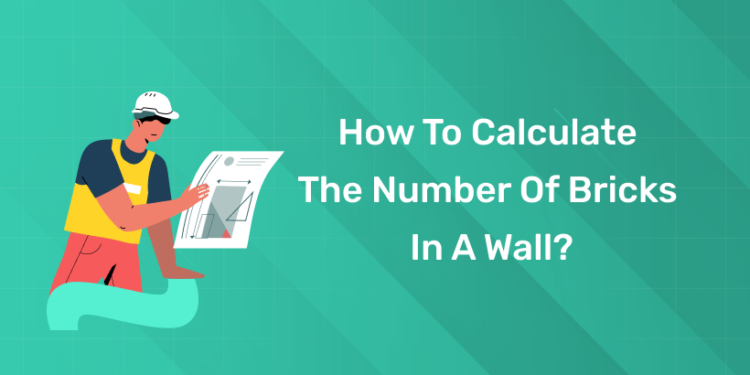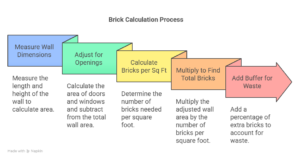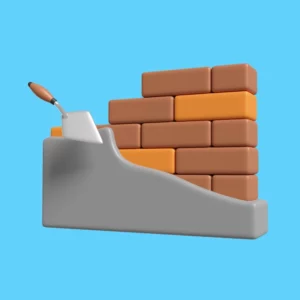Table of Contents
Introduction
Imagine building a wall and running out of bricks halfway through the job. That’s a mess you don’t want to face. Welcome to “How to Calculate the Number of Bricks in a Wall?” This blog shows you how to get it right. It’s for homeowners, builders, civil engineers, or anyone with a project.
Counting bricks saves time and cash. You’ll know exactly what to buy before you start. This guide breaks down calculate bricks in a wall so it’s easy. No guesswork, just solid steps. Want to nail your next build? Let’s stack up the facts and get going!
Why Calculate Bricks?
1: What is the main purpose of a Bill of Quantities (BoQ)?
Figuring out how many bricks you need isn’t just busywork. Think of it as your ticket to a smooth project. You avoid trips back to the store mid-build. It keeps your budget tight and your timeline on track. That’s why this skill matters big time.
Bricks aren’t cheap. Buying too many wastes money you could spend elsewhere. Get too few and delays pile up fast. A good count stops both headaches. You plan better and look smart doing it. Precision beats eyeballing every day of the week.
This hits home for real. A 2024 survey said 40% of DIY folks miscount materials. That’s cash and hours down the drain. Knowing how many bricks for a wall fixes that. You’ll finish strong without stress. Let’s see what changes the number next!
Get hands-on with our Quantity Surveyor course—sign up for a free demo!
Master Quantity Surveying – Build a Rewarding Career Today!
Gain in-demand skills in cost estimation, project budgeting, and contract management with our Quantity Surveying Course. Learn from industry experts and boost your career in construction and infrastructure. Enroll now and take the first step toward success!
Know MoreFactors Affecting Brick Count
Not every wall needs the same brick pile. Picture a short fence versus a tall house side. Size, style and extras shift the count. Here’s what you need to watch to get it right.
Wall size sets the base. Height and length tell you the area to cover. A 10-foot long, 5-foot high wall needs more than a tiny one. Measure it exact or you’re off from the start. Bigger means more bricks, plain and simple.
Brick type plays a part too. Standard bricks differ from big blocks in size. A common brick is about 8 inches long with mortar. Smaller or larger ones change how many fit. You pick what works for your build.
Openings cut the total down. Think windows or doors in the wall. No bricks go there so subtract that space. A 2-foot door drops the count quick. Miss this and you’ll buy too much.Mortar joints complicate things. They take up space between bricks, about half an inch. More joints means fewer bricks fit in tight. Wall thickness matters too. Double layers use twice as many. All this changes the number. Let’s get started!
Step-by-Step Calculation Guide
Counting bricks is hard, but with a plan it’s easy. Picture yourself measuring and figuring it out. This brick calculation formula works every time. Follow these steps and you’ll know the number fast.
- Step one is measuring the wall: Grab a tape and get the length in feet. Then measure the height from bottom to top. Multiply those two numbers for the area. A 10-foot long, 5-foot high wall is 50 square feet.
- Step two adjusts for openings: Measure any doors or windows in feet. Multiply their length and height for area. Subtract that from the wall total. A 2-foot by 3-foot window is 6 square feet off.
- Step three finds bricks per square foot: A standard brick with mortar takes 0.148 square feet. Divide 1 by 0.148 to get about 6.75 bricks per square foot. That’s your magic number for most builds. Use it every time.
- Step four multiplies it out: Take your wall area after openings and times it by 6.75. For 44 square feet you need 297 bricks. Round up to 300 for extras. That covers breaks or cuts you’ll hit.
- Step five adds a buffer: Pros say add 5% more for waste. For 300 bricks that’s 15 extra so 315 total. You’re good to go without running short.
This method is calculate bricks in a wall simple. Let’s try some real cases next!
Practical Examples
Numbers make sense when you see them work. Picture two walls you might build today. These examples will make how many bricks for a wall clear. You’ll be ready to count anything after this.
First, a garden wall. It’s 8 feet long and 3 feet high. Multiply 8 by 3 to get 24 square feet. No doors or windows here so it’s 24. Times 6.75 bricks per square foot equals 162 bricks. Add 5% more, about 8 bricks. You need 170 total for this job.Second, a house wall with a window. It’s 12 feet long and 10 feet high. That’s 120 square feet to start. A window is 3 feet by 4 feet, so 12 square feet. Subtract that, 108 square feet. Times 6.75 equals 729 bricks. Add 5% more, about 8 bricks. You need 737 total for this job.
Third, a thick garage wall. It’s 15 feet long, 8 feet high, double-layered. One side is 120 square feet, no openings. Times 6.75 makes 810 bricks per side. Double it for both sides, so 1620 bricks. Add 5%, about 81 extra, and you need 1701 bricks. You can too, for any wall size. It’s real math that saves real trouble. Let’s get to why this is good for you!
Start Your Journey To A Prosperous Career ! Study Quantity Surveying With Professional Mentors!
Master Quantity Surveying – Build a Rewarding Career Today!
Gain in-demand skills in cost estimation, project budgeting, and contract management with our Quantity Surveying Course. Learn from industry experts and boost your career in construction and infrastructure. Enroll now and take the first step toward success!
Know MoreConclusion
Counting bricks isn’t some builder’s secret anymore. You’ve learned why it matters to get the number right. Size, openings, and brick type all play in, and you know them now. The steps to figure brick calculation formula are yours, simple and sure. Examples show it works for any project you pick up. You’re set to build smart, no sweat.
This skill changes your game fast. You save cash by buying just what you need in 2025. No more stalled jobs or extra store runs. Walls go up smooth when you plan this good. Builders say projects finish 20% faster with solid counts. You’ll feel that win every time you stack a row. The Entri Quantity Surveying Course boosts you more with pro tips. You’ll finish jobs fast and look good doing it. Start today and stack bricks like a champ!
Master Quantity Surveying – Build a Rewarding Career Today!
Gain in-demand skills in cost estimation, project budgeting, and contract management with our Quantity Surveying Course. Learn from industry experts and boost your career in construction and infrastructure. Enroll now and take the first step toward success!
Know MoreFrequently Asked Questions
Why should I calculate bricks before building a wall?
Counting bricks stops you from buying too many or too few for your wall. It saves cash and keeps your project on track. You won’t run out mid-build or waste leftovers. A good count makes you look smart and ready in 2025.
What’s the first step to figure out bricks for a wall?
Start by measuring your wall’s length and height in feet with a tape. Multiply those to get the total area fast. That number sets up everything else you need. It’s the base for knowing how many bricks for a wall easy.
How do windows change the brick count in a wall?
Windows cut down bricks since no bricks go where they sit in the wall. Measure the window’s length and height, then subtract that area. It drops your total quick. You’ll buy less and avoid extra with this step every time.
What’s a simple brick calculation formula to use?
Take your wall area in square feet and multiply by 6.75 for standard bricks. That’s bricks per square foot with mortar included. Add 5% more for breaks or cuts. This trick gives you a solid number to shop with fast.
How many bricks fit in one square foot of wall?
A standard brick with mortar takes up about 0.148 square feet each time. Divide 1 by 0.148, and you get 6.75 bricks per square foot. That’s the key to count right. It works for most walls you’ll build now.
Does wall thickness affect how many bricks I need?
Yes, a thicker wall doubles or triples the bricks you need for the job. A single layer uses one count, but two layers use twice as much. Measure each side separate. You’ll stack more to make it strong and steady.
Why add extra bricks to my final count?
Extra bricks cover ones that break or need cutting during the build. Pros say 5% more stops you running short. It’s a buffer for mistakes or waste. You’ll finish smooth without a last-minute store trip in 2025.
Can I calculate bricks for a curved wall the same way?
Curved walls use the same steps, but measure the length along the curve. Height stays straight up, then multiply for area. Adjust for any odd shapes or cuts. It’s close enough to get calculate bricks in a wall right.
How do I know if my brick size changes the count?
Different brick sizes shift how many fit in a wall every time. Standard is 8 inches long with mortar, but check yours. Bigger bricks mean fewer; smaller means more. Measure one, adjust the formula, and you’re set fast.
What happens if I don’t calculate bricks before starting?
Skipping the count risks running out or buying way too many bricks. You’ll waste time dashing to the store mid-job. Cash flies out with extras you don’t use. A quick brick calculation formula keeps your build smooth and cheap.



























